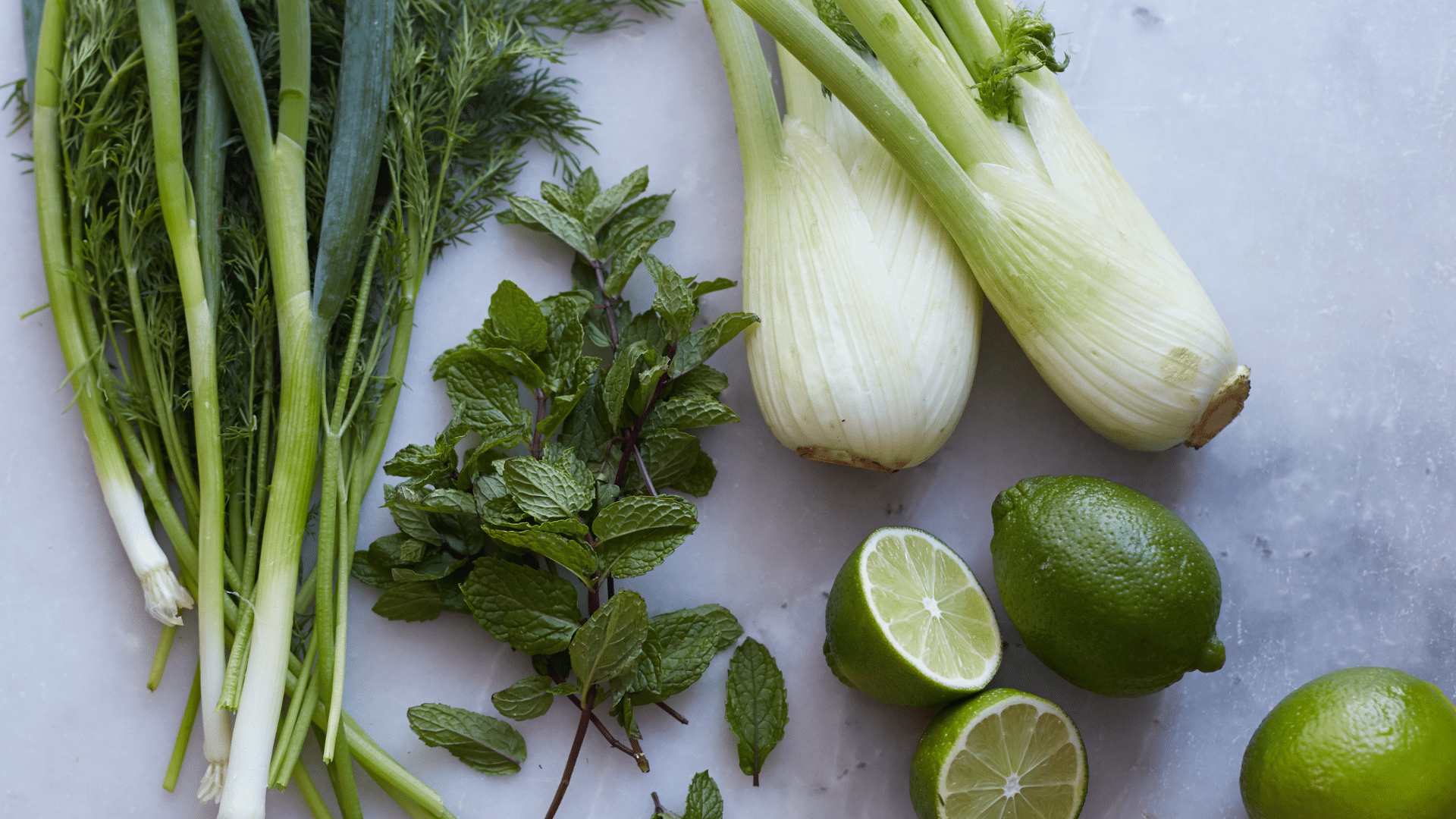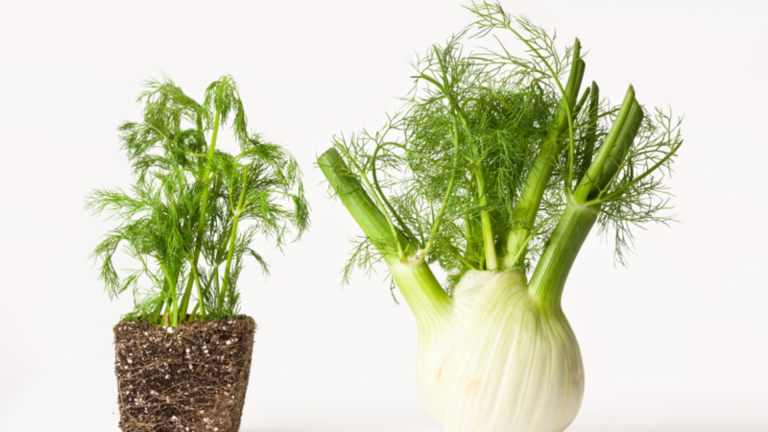If you stroll through a grocery store or visit the herb section at your favorite market, you’ve probably seen fennel and dill sitting side by side.
Their green, feathery fronds often look nearly identical, and I’ll admit, I used to mix them up too. However, once you understand their differences, you realize how much choosing the right one can impact your cooking and even your gardening.
I always stop to admire their delicate leaves, but I also think about the flavors they bring and how they grow.
Fennel offers bold licorice notes and a hearty bulb, while dill gives you bright, grassy freshness.
In this guide, I’ll help you recognize their unique traits and decide which one works best for you.
You’ll see how each herb brings its own charm, from flavor to fragrance to pollinator appeal. Once you know the difference, you won’t go back to guessing.
Fennel vs. Dill: What’s the Difference?

Fennel (Foeniculum vulgare) and dill (Anethum graveolens) belong to the same plant family, Apiaceae, which is why they look so similar at first glance.
But when I started paying attention to their structure, flavor, and how they grow, I realized they couldn’t be more different. This is how I break them down when I need to choose the right one:
Fennel:
- A hardy perennial herb that grows back year after year in mild climates.
- Forms a large, edible white bulb at its base, often used as a vegetable.
- Grows tall and bushy, sometimes reaching up to 6 feet.
- Produces yellow umbrella-shaped flowers and sweet, licorice-scented seeds.
- Offers three uses: bulb for cooking, fronds for garnish, and seeds for spice.
Dill:
- A delicate annual that completes its life cycle in one season.
- Has no bulb, only a slender, green, flexible stalk.
- Features fine, lace-like foliage that’s softer and lighter than fennel.
- Blooms with smaller yellow umbels that often go into pickle jars.
- Known for its fresh, grassy flavor, it is used mainly raw for a finishing touch.
Once you become familiar with their traits, it’s easy to distinguish between fennel and dill and choose the best one for your needs.
How to Tell Them Apart:
| Feature | Fennel | Dill |
|---|---|---|
| Leaf Shape | Feathery, thin, thread-like fronds | Fern-like, finely divided, airy |
| Plant Height | Up to 6 feet (2 m), tall and sturdy | 15–60 inches (40–150 cm), slender |
| Bulb | Large, edible white bulb at base | No bulb; just slender stalk |
| Flowers | Yellow, umbrella-shaped clusters | Yellow, smaller umbels |
| Seeds | Long, grooved, curved, aromatic | Shorter, oval, ridged, flavorful |
I use the bulb as the clearest signal: fennel boasts one, dill does not.
Flavor and Culinary Uses of Fennel And Dill

Fennel and dill may look similar, but their flavors take your dishes in completely different directions. I’ve found that choosing the right one changes everything, from the mood of a meal to how it complements other ingredients.
Fennel
Fennel offers a bold, unmistakable licorice or anise aroma, especially when you slice into the bulb or crush the seeds. Its flavor is sweet, mildly spicy, and slightly cooling, similar to black licorice or aniseed. What I love most is how fennel feels like three ingredients in one:
- Bulb: Crisp and juicy when raw in salads, mellow and sweet when roasted or braised, perfect for Mediterranean dishes.
- Fronds: Finely chopped as a garnish over fish, soups, or grain bowls; they add both texture and fragrance.
- Seeds: Toasted and used as a spice in sausages, breads, teas, and curries, especially in Italian and Indian cooking.
Florence fennel provides the bulb as a vegetable, while common fennel is often grown for its seeds and leafy greens.
Dill
Dill brings a light, grassy, and tangy flavor with a delicate note of anise. It feels much brighter and fresher than fennel, and it doesn’t linger with that deep licorice aftertaste. I reach for dill when I want a touch of green flavor without overwhelming the dish.
- Leaves (dill weed): Stirred into potato salads, mixed into yogurt sauces, or sprinkled over salmon, cucumbers, and beet salads, especially in Scandinavian or Eastern European recipes.
- Flowers and Seeds: Essential in pickling, you can’t make a classic dill pickle without using the flower heads or seeds for that sharp, tangy bite.
Dill’s strength is in raw or barely cooked applications. I usually add it at the end of cooking to preserve its flavor and brightness.
Flavor Substitution: Can I Swap One for the Other? You can substitute fennel fronds for dill in an emergency, but the flavor will shift from tangy and fresh to sweet and licorice-heavy, fundamentally changing the dish.
I avoid this swap except in small garnishing roles. Dill’s flavor is too gentle to stand in for fennel, especially where the bulb or seeds are needed.
At a glance:
| Herb | Best With | Preparation Method |
|---|---|---|
| Fennel | Roasted meats, salads, stews, and tea | Roasted, sautéed, raw, or as a spice |
| Dill | Fish, potatoes, pickles, yogurt | Raw, as garnish, pickled, and dips |
Nutritional And Medicinal Benefits of Fennel and Dill
I find both herbs offer health perks, but the details vary:
- Dill is higher in vitamin C, manganese, iron, and calcium, making just a handful of dill leaves a potent nutrient boost, especially for immune and bone health.
- Fennel offers more fiber, potassium, and moderate levels of vitamin C, especially if you enjoy the bulb, which is a superb addition for supporting digestion and heart health. The seeds contain antioxidant, antimicrobial, and anti-inflammatory compounds. Bulbs and seeds even appear as herbal remedies across many cultures.
- Dill supports digestion, has mild diuretic effects, and sometimes soothes hiccups or colic. You can use dill “oil” for its carminative (gas-relieving) properties.
- Fennel is prized as a digestive tonic, mild anti-inflammatory, and galactagogue (increases milk flow for nursing mothers). Fennel tea is a traditional home remedy for stomachaches or colic.
| Nutrient | Fennel (bulb) | Dill (leaves) |
|---|---|---|
| Vitamin C | Good | Excellent |
| Fiber | Excellent | Good |
| Iron | Fair | High |
| Potassium | High | Moderate |
| Manganese | Moderate | High |
The seeds of both are used in Ayurveda and traditional medicine, not just for flavor but for mild health support.
How to Grow Fennel and Dill
If you like growing herbs, you’ll find each offers unique rewards and quirks.
Growing Fennel
- Soil and Sun: Prefers full sun, loose and rich soil, and tolerates drought well once established. Good drainage is key.
- Planting: Sow seeds 1/4 inch deep in warm soil (50–75°F). Thin seedlings as bulbs begin to swell, allowing space for full growth.
- Time to Maturity: Florence fennel matures in 60–90 days. Consistent water helps bulbs stay crisp, while flowers attract pollinators.
- Perennial (in mild climates): The plant self-seeds prolifically, and I often see it return year after year, especially if flower heads are left alone.
Growing Dill
- Soil and Sun: Full sun to part shade, well-drained, fertile soil. Dill is less demanding than fennel about richness.
- Planting: Direct sow after the last frost; it dislikes transplanting. Lightly cover seeds, which germinate quickly in warmth.
- Time to Maturity: About 40–60 days for leaf harvest. Flower heads and seeds follow quickly, especially in hot weather.
- Annual: Usually completes its life in one growing season, but may seed itself for unexpected volunteers the next year.
Quick Growing Pro Tips: I find dill and fennel “compete” in the soil, so I recommend you give them some distance if you grow both. Their similar shapes and aromas can cross-attract pests or slow each other’s development.
Summary of Key Differences: Fennel v/s Dill
| Quality | Fennel | Dill |
|---|---|---|
| Family | Apiaceae | Apiaceae |
| Life cycle | Perennial (sometimes biennial) | Annual |
| Main edible parts | Bulb, fronds, seeds | Leaves/stems, seeds |
| Taste | Strong licorice/anise, mildly sweet | Light, grassy, tangy, faintly anise |
| Popular use | Roasted veg, spices in sausage/bread | Pickles, salmon, yogurt, and dips |
| Plant height | Up to 6 feet (tall, bushy) | 1–5 feet (lacy, slender) |
| Nutrition | More fiber, potassium, and bulb-rich | More vitamin C, iron, and leaves are potent |
Conclusion
When I bring home fennel or dill, I know I’m choosing more than an herb; they represent centuries of flavor, culture, and utility in the kitchen and garden.
Fennel, with its crisp bulb and licorice intensity, transforms roasts, salads, and infusions, while its feathery leaves brighten Mediterranean platters.
Dill, meanwhile, brings breezy freshness to fish, potatoes, and pickles, adding zing without overpowering the dish.
You get a burst of nutrition and simple joy from both; each supports healthy digestion, appeals to pollinators, and stands out with unique character.
Next time you face a choice between fennel’s sweet depth and dill’s vivid crispness, I hope you’ll appreciate their brilliance, savoring each for the moments and recipes where they truly shine













